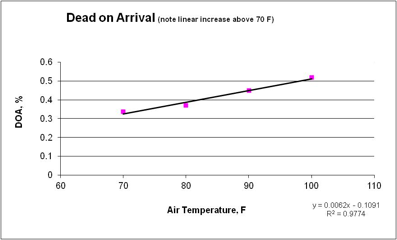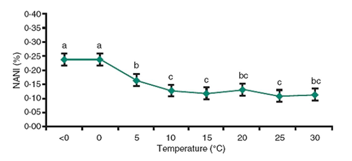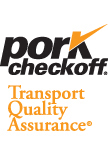The Pig Transport Site
Table of Contents
- What is the Transport Experience and Why is it Negative?
- Educational Resources for Producers, Transporters and Processors
- Current Transport Research
- Pig Transport During Warm Weather
- Pig Transport During Cold Weather
- References from Our Laboratory
- Private Site for Collaborators
- USA Laws Related to Farm Animals

Our laboratory has been studying pig transport for about 20 years. We have examined conditions before, during and after transport of pigs of varying ages. We have also studied some other species as the need surfaced.
Pigs may transported at weaning, end-of-nursery (about 40-50 lb, also called feeder pigs), to slaughter at a final weight in the USA of 250-300 lb, and breeding stock are transported. Each age of pig responds differently to transport. Previous experience with transport and its elements are understood at some level and this gives us opportunities to provide interventions.
Back to topWhat is the Transport Experience and Why is it Negative?
Transport by itself does not have to be negative. Consider a dog that jumps up into a car to go for a ride at any opportunity. That animal is not stressed by that transport experience. But consider, in sharp contrast, a pig that is taken from its mother and placed in a strange environment that is cold (or hot) with no food or water. We understand that transport is a negative or stressful experience because of at least these factors:
- The pig's previous experiences
- The novelty of the transport experience
- Degree of human interaction before transport (ex., in finishing pens)
- Temperature and relative humidity extremes
- Wind currents
- Bright sunlight if they were raised inside a building
- Footing and flooring
- Ramps with an up or down slope
- Fencing materials that might be foreign or distracting
- Vibrations and movements that may induce motion sickness
Educational Resources for Producers, Transporters and Processors
Current Transport Research
We have a number of on-going studies on pig transport. A large National Pork Board-funded study examined use of bedding during transport of finishing pigs to market. A summary of that work is found in this presentation given by Avi Sapokta (a PhD candidate) at the 2012 World Pork Expo.
Current work is examining boarding levels (for ventilation control) and misting during hot weather.
Back to topPig Transport During Warm Weather
We know from the field that the rate of dead on arrival (DOA) is higher in the summer than in the cooler months. Furthermore, from Sutherland et al., (2009), we know that DOA increases from 70 to over 100 F (21 to 38 C).

Figure. Warm outside air temperature is associated with a rise in DOA pigs at the plant. While the rate of DOA was not related to air temperatures below 70 F (21 C), above 70 C, the rate if DOA steadily increased (Sutherland et al., 2009).
How to know when pigs are getting hot?
When pigs get hot, they show signs of stress. Among these signs are increased breathing rates and open mouth breathing, (see video below), redness of skin, and unwillingness or inability to walk. Pigs lack functional sweat glands and so if they are in a transport truck or trailer and they become hot, they cannot sweat to cool down. At this point, the only interventions available are to move air (drive truck or put fans on) or wet the pigs – or preferably both.
When the air temperature is above 70 F, the producer, transporter or plant should take measures to cool the pigs. The warmer it is, the more interventions should be used to cool the pigs.
Situations that make warm weather harder on pigs include the following:
- Air temperatures above 70 F
- Lack of air movement
- Use of too much bedding (see presentation below about bedding)
- 9 bales of bedding/trailer at 30 C (86 F) or warmer will more than double the rate of DOA pigs.
Pig Transport During Cold Weather
During cool and cold weather, the main outcome is an increase in the rate of down pigs (also called fatigued, non-ambulatory-non-injured, NANI, stressed, subjects or suspects). The rate of NANI pigs can more than double in cool or cold weather. NANI pigs do not have the energy reserves to walk and sometimes even stand. In cold weather, this is observed more often.

Figure. Increase in NANI/down pig with cooler air temperatures. Taken from Sutherland
et al., (2009).10 C represents about 50 F. Note the steady rise in NANI % below 10
C.
How do I know when pigs are too cold?
Pigs will be too cold when the air temperature is below 50 F (10 C). If bedding is used, you can take 10 F off that critical temperature. If pigs can huddle, another 10 F can come off the effective environmental temperature (the temperature that the pig “feels” or senses). Thus, at an air temperature of 30 F and with bedding and other pigs, the pigs will not be particularly cold. Cold pigs have a cool surface temperature to the touch and they will seek to huddle. If they can't huddle with other pigs, they will shiver. When you see pigs shivering, they are especially cold.
Back to topReferences from Our Laboratory
- McGlone, J. J., J. L. Salak, E. A. Lumpkin, R. I. Nicholson, M. Gibson and R. Norman. 1993. Shipping stress and social status effects on pig performance, plasma cortisol, natural killer cell activity and leukocyte numbers. J. Animal Science. 71:888-896.
- Hicks, T. A., J. J. McGlone, C. Scott Whisnant, H. G. Kattesh and Reid L. Norman. 1998. Behavioral, endocrine, immune and performance measures for pigs exposed to acute stress. J. Animal Science. 76: 474-483.
- Hill, J. D., J. J. McGlone, S. D. Fullwood and M. F. Miller. 1998. Environmental enrichment influences on pig behavior, performance and meat quality. Applied Animal Behavior Science. 57:51-68.
- McGlone, J. J., R. McPherson and D. L. Anderson. 2004. Case study: Moving devices for market-sized pigs: efficacy of electric prod, board, paddle or flag. Prof. Anim. Sci. 20:518-523.
- Sutherland MA, Erlandson K, Connor JF, Salak-Johnson JL, Matzat P, Smith JF, McGlone JJ. 2008. Health of non-ambulatory, non-injured pigs at processing. Livestock Sci. 116:237-245.
- Lewis, C.R.G., and J.J. McGlone, 2007. Moving finishing pigs in different group sizes: cardiovascular responses, time, and ease of handling. Livestock Science 107:86-90.
- Lewis, C. R. G. and J. J. McGlone. 2008. Modelling feeding behavior, rate of passage, and daily feeding cycles as possible causes of fatigued pigs. Animal. 2(4):600-605.
- Stull, C. L., J. Morrow, B. A. Aldridge, J. L. Stott, J. J. McGlone. 2008. Immunophysiological responses in horses to a 12-hour rest during 24 hours of road transport. Vet. Record. 162:609-614.
- Sutherland MA, McDonald A, McGlone JJ.2009. Environmental, trailer, and gender effects on the percentage of dead and non-ambulatory pigs during transport. Vet Record 165:13-18.
- Sutherland MA, Bryer PJ, Davis BL, McGlone JJ. 2009. Space requirements of weaned pigs during a 60 minute transport in summer. J. Anim. Sci. 87:363-370.
- Sutherland MA, N. Krebs, J. S. Smith, J. W. Dailey, J. A. Carroll, and J. J. McGlone. 2009. The effect of three space allowances on the physiology and behavior of weaned pigs during transportation. Livestock Science. 126:183-188.
- Krebs, N. and J. J. McGlone. 2009. Effects of exposing pigs to moving and odors in a simulated chute. Appl. Anim. Behav. Sci. 116:179-185.
- Sutherland MA, Bryer PJ, Davis BL, McGlone JJ. 2010. A multi-disciplinary approach to assess the welfare of weaned pigs during transport at three space allowances. J. Appl. Anim. Welfare Sci. 13;237-249.
- Lewis, C.R.G, N. Krebs, L.E. Hulbert, and J. J. McGlone. 2010. The use of a putative maternal pheromone during transport and the effect of trailer temperature on pig losses and welfare. Animal Production Science. 50:1-9.
- Bryer, P. J., M. A. Sutherland, B. L. Davis, J. F. Smith and J. J. McGlone. 2011. The effect of transport and space allowance on the physiology of breeding age gilts. Livestock Sci. 137:58-65.
- Hill, J. D., J. J. McGlone, S. D. Fullwood and M. F. Miller. 1998. Environmental enrichment influences on pig behavior, performance and meat quality. Applied Animal Behavior Science. 57:51-68.
Private Site for Collaborators
USA Laws Related to Farm Animals
Laboratory of Animal Behavior, Physiology and Welfare
-
Address
1308 Indiana Ave Lubbock, TX 79409-2141 -
Phone
806.834.8275 -
Email
john.mcglone@ttu.edu


